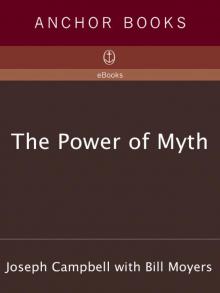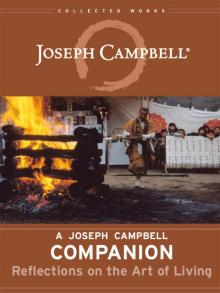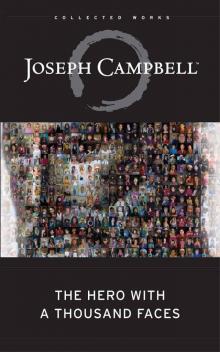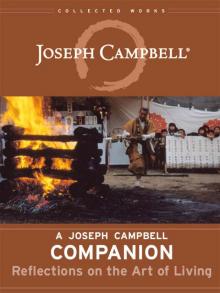- Home
- Joseph Campbell
The Power of Myth
The Power of Myth Read online
Also by Joseph Campbell
Where the Two Came to Their Father: A Navaho War Ceremonial (with Maud Oakes and Jeff King)
A Skeleton Key to Finnegans Wake (with Henry Morton Robinson)
The Hero with a Thousand Faces
The Masks of God: Primitive Mythology
The Masks of God: Oriental Mythology
The Masks of God: Occidental Mythology
The Masks of God: Creative Mythology
The Flight of the Wild Gander
The Mythic Image
Myths to Live By
Historical Atlas of World Mythology
I. The Way of the Animal Powers
II. The Way of the Seeded Earth (forthcoming)
The Inner Reaches of Outer Space
EDITED BY JOSEPH CAMPBELL
The Portable Arabian Nights
The Portable Jung
Myths, Dreams, and Religion
Papers from the Eranos Yearbooks (6 volumes)
EDITED AND COMPLETED FROM
THE POSTHUMA OF HEINRICH ZIMMER
Myths and Symbols in Indian Art and Civilization
The King and the Corpse
Philosophies of India
The Art of Indian Asia (2 volumes)
FIRST ANCHOR BOOKS EDITION, JULY 1991
Copyright © 1988 by Apostrophe S Productions, Inc., and Alfred van der Marck Editions
All rights reserved under International and Pan-American Copyright Conventions. Published in the United States by Anchor Books, a division of Random House, Inc., New York, and simultaneously in Canada by Random House of Canada Limited, Toronto. The fully illustrated edition of The Power of Myth was originally published in both hardcover and paperback by Doubleday in 1988. The Anchor Books edition is published by arrangement with Doubleday.
ANCHOR BOOKS and colophon are registered trademarks of Random House, Inc.
Grateful acknowledgment is made to Barnes & Noble Books, Totowa, New Jersey, for permission to quote from “The Second Coming” by William Butler Yeats.
Campbell, Joseph, 1904–
The power of myth / Joseph Campbell, with Bill Moyers;
Betty Sue Flowers, editor.—1st Anchor Books ed.
p. cm.
1. Myth. 2. Campbell, Joseph, 1904–Interviews. 3. Religion historians—United States—Interviews. I. Moyers, Bill D. II. Flowers, Betty S. III. Title.
[BL304.C36 1990] 90-23860
291.1′3—dc20
eISBN: 978-0-307-79472-7
www.anchorbooks.com
v3.1
To Judith, who has long heard the music
CONTENTS
Cover
Other Books by This Author
Title Page
Copyright
Dedication
EDITOR’S NOTE
INTRODUCTION BY BILL MOYERS
I MYTH AND THE MODERN WORLD
II THE JOURNEY INWARD
III THE FIRST STORYTELLERS
IV SACRIFICE AND BLISS
V THE HERO’S ADVENTURE
VI THE GIFT OF THE GODDESS
VII TALES OF LOVE AND MARRIAGE
VIII MASKS OF ETERNITY
About the Author
EDITOR’S NOTE
This conversation between Bill Moyers and Joseph Campbell took place in 1985 and 1986 at George Lucas’ Skywalker Ranch and later at the Museum of Natural History in New York. Many of us who read the original transcripts were struck by the rich abundance of material captured during the twenty-four hours of filming—much of which had to be cut in making the six-hour PBS series. The idea for a book arose from the desire to make this material available not only to viewers of the series but also to those who have long appreciated Campbell through reading his books.
In editing this book, I attempted to be faithful to the flow of the original conversation while at the same time taking advantage of the opportunity to weave in additional material on the topic from wherever it appeared in the transcripts. When I could, I followed the format of the TV series. But the book has its own shape and spirit and is designed to be a companion to the series, not a replica of it. The book exists, in part, because this is a conversation of ideas worth pondering as well as watching.
On a more profound level, of course, the book exists because Bill Moyers was willing to address the fundamental and difficult subject of myth—and because Joseph Campbell was willing to answer Moyers’ penetrating questions with self-revealing honesty, based on a lifetime of living with myth. I am grateful to both of them for the opportunity to witness this encounter, and to Jacqueline Kennedy Onassis, the Doubleday editor, whose interest in the ideas of Joseph Campbell was the prime mover in the publication of this book. I am grateful, also, to Karen Bordelon, Alice Fisher, Lynn Cohea, Sonya Haddad, Joan Konner, and John Flowers for their support, and especially to Maggie Keeshen for her many retypings of the manuscript and for her keen editorial eye. For help with the manuscript, I am grateful to Judy Doctoroff, Andie Tucher, Becky Berman, and Judy Sandman. The major task of illustration research was done by Vera Aronow, Lynn Novick, Elizabeth Fischer, and Sabra Moore, with help from Annmari Ronnberg. Both Bill Moyers and Joseph Campbell read the manuscript and offered many helpful suggestions—but I am grateful that they resisted the temptation to rewrite their words into book talk. Instead, they let the conversation itself live on the page.
—BETTY SUE FLOWERS
University of Texas at Austin
INTRODUCTION
For weeks after Joseph Campbell died, I was reminded of him just about everywhere I turned.
Coming up from the subway at Times Square and feeling the energy of the pressing crowd, I smiled to myself upon remembering the image that once had appeared to Campbell there: “The latest incarnation of Oedipus, the continued romance of Beauty and the Beast, stands this afternoon on the corner of Forty-second Street and Fifth Avenue, waiting for the traffic light to change.”
At a preview of John Huston’s last film, The Dead, based on a story by James Joyce, I thought again of Campbell. One of his first important works was a key to Finnegans Wake. What Joyce called “the grave and constant” in human sufferings Campbell knew to be a principal theme of classic mythology. “The secret cause of all suffering,” he said, “is mortality itself, which is the prime condition of life. It cannot be denied if life is to be affirmed.”
Once, as we were discussing the subject of suffering, he mentioned in tandem Joyce and Igjugarjuk. “Who is Igjugarjuk?” I said, barely able to imitate the pronunciation. “Oh,” replied Campbell, “he was the shaman of a Caribou Eskimo tribe in northern Canada, the one who told European visitors that the only true wisdom lives far from mankind, out in the great loneliness, and can be reached only through suffering. Privation and suffering alone open the mind to all that is hidden to others.’ ”
“Of course,” I said, “Igjugarjuk.”
Joe let pass my cultural ignorance. We had stopped walking. His eyes were alight as he said, “Can you imagine a long evening around the fire with Joyce and Igjugarjuk? Boy, I’d like to sit in on that.”
Campbell died just before the twenty-fourth anniversary of John F. Kennedy’s assassination, a tragedy he had discussed in mythological terms during our first meeting years earlier. Now, as that melancholy remembrance came around again, I sat talking with my grown children about Campbell’s reflections. The solemn state funeral he had described as “an illustration of the high service of ritual to a society,” evoking mythological themes rooted in human need. “This was a ritualized occasion of the greatest social necessity,” Campbell had written. The public murder of a president, “representing our whole society, the living social organism of which ourselves were the members, taken away at a moment of exuberant life, required
a compensatory rite to reestablish the sense of solidarity. Here was an enormous nation, made those four days into a unanimous community, all of us participating in the same way, simultaneously, in a single symbolic event.” He said it was “the first and only thing of its kind in peacetime that has ever given me the sense of being a member of this whole national community, engaged as a unit in the observance of a deeply significant rite.”
That description I recalled also when one of my colleagues had been asked by a friend about our collaboration with Campbell: “Why do you need the mythology?” She held the familiar, modern opinion that “all these Greek gods and stuff” are irrelevant to the human condition today. What she did not know—what most do not know—is that the remnants of all that “stuff” line the walls of our interior system of belief, like shards of broken pottery in an archaeological site. But as we are organic beings, there is energy in all that “stuff.” Rituals evoke it. Consider the position of judges in our society, which Campbell saw in mythological, not sociological, terms. If this position were just a role, the judge could wear a gray suit to court instead of the magisterial black robe. For the law to hold authority beyond mere coercion, the power of the judge must be ritualized, mythologized. So must much of life today, Campbell said, from religion and war to love and death.
Walking to work one morning after Campbell’s death, I stopped before a neighborhood video store that was showing scenes from George Lucas’ Star Wars on a monitor in the window. I stood there thinking of the time Campbell and I had watched the movie together at Lucas’ Skywalker Ranch in California. Lucas and Campbell had become good friends after the filmmaker, acknowledging a debt to Campbell’s work, invited the scholar to view the Star Wars trilogy. Campbell reveled in the ancient themes and motifs of mythology unfolding on the wide screen in powerful contemporary images. On this particular visit, having again exulted over the perils and heroics of Luke Skywalker, Joe grew animated as he talked about how Lucas “has put the newest and most powerful spin” to the classic story of the hero.
“And what is that?” I asked.
“It’s what Goethe said in Faust but which Lucas has dressed in modern idiom—the message that technology is not going to save us. Our computers, our tools, our machines are not enough. We have to rely on our intuition, our true being.”
“Isn’t that an affront to reason?” I said. “And aren’t we already beating a hasty retreat from reason, as it is?”
“That’s not what the hero’s journey is about. It’s not to deny reason. To the contrary, by overcoming the dark passions, the hero symbolizes our ability to control the irrational savage within us.” Campbell had lamented on other occasions our failure “to admit within ourselves the carnivorous, lecherous fever” that is endemic to human nature. Now he was describing the hero’s journey not as a courageous act but as a life lived in self-discovery, “and Luke Skywalker was never more rational than when he found within himself the resources of character to meet his destiny.”
Ironically, to Campbell the end of the hero’s journey is not the aggrandizement of the hero. “It is,” he said in one of his lectures, “not to identify oneself with any of the figures or powers experienced. The Indian yogi, striving for release, identifies himself with the Light and never returns. But no one with a will to the service of others would permit himself such an escape. The ultimate aim of the quest must be neither release nor ecstasy for oneself, but the wisdom and the power to serve others.” One of the many distinctions between the celebrity and the hero, he said, is that one lives only for self while the other acts to redeem society.
Joseph Campbell affirmed life as adventure. “To hell with it,” he said, after his university adviser tried to hold him to a narrow academic curriculum. He gave up on the pursuit of a doctorate and went instead into the woods to read. He continued all his life to read books about the world: anthropology, biology, philosophy, art, history, religion. And he continued to remind others that one sure path into the world runs along the printed page. A few days after his death, I received a letter from one of his former students who now helps to edit a major magazine. Hearing of the series on which I had been working with Campbell, she wrote to share how this man’s “cyclone of energy blew across all the intellectual possibilities” of the students who sat “breathless in his classroom” at Sarah Lawrence College. “While all of us listened spellbound,” she wrote, “we did stagger under the weight of his weekly reading assignments. Finally, one of our number stood up and confronted him (Sarah Lawrence style), saying: ‘I am taking three other courses, you know. All of them assigned reading, you know. How do you expect me to complete all this in a week?’ Campbell just laughed and said, ‘I’m astonished you tried. You have the rest of your life to do the reading.’ ”
She concluded, “And I still haven’t finished—the never ending example of his life and work.”
One could get a sense of that impact at the memorial service held for him at the Museum of Natural History in New York. Brought there as a boy, he had been transfixed by the totem poles and masks. Who made them? he wondered. What did they mean? He began to read everything he could about Indians, their myths and legends. By ten he was into the pursuit that made him one of the world’s leading scholars of mythology and one of the most exciting teachers of our time; it was said that “he could make the bones of folklore and anthropology live.” Now, at the memorial service in the museum where three quarters of a century earlier his imagination had first been excited, people gathered to pay honor to his memory. There was a performance by Mickey Hart, the drummer for the Grateful Dead, the rock group with whom Campbell shared a fascination with percussion. Robert Bly played a dulcimer and read poetry dedicated to Campbell. Former students spoke, as did friends whom he had made after he retired and moved with his wife, the dancer Jean Erdman, to Hawaii. The great publishing houses of New York were represented. So were writers and scholars, young and old, who had found their pathbreaker in Joseph Campbell.
And journalists. I had been drawn to him eight years earlier when, self-appointed, I was attempting to bring to television the lively minds of our time. We had taped two programs at the museum, and so compellingly had his presence permeated the screen that more than fourteen thousand people wrote asking for transcripts of the conversations. I vowed then that I would come after him again, this time for a more systematic and thorough exploration of his ideas. He wrote or edited some twenty books, but it was as a teacher that I had experienced him, one rich in the lore of the world and the imagery of language, and I wanted others to experience him as teacher, too. So the desire to share the treasure of the man inspired my PBS series and this book.
A journalist, it is said, enjoys a license to be educated in public; we are the lucky ones, allowed to spend our days in a continuing course of adult education. No one has taught me more of late than Campbell, and when I told him he would have to bear the responsibility for whatever comes of having me as a pupil, he laughed and quoted an old Roman: “The fates lead him who will; him who won’t they drag.”
He taught, as great teachers teach, by example. It was not his manner to try to talk anyone into anything (except once, when he persuaded Jean to marry him). Preachers err, he told me, by trying “to talk people into belief; better they reveal the radiance of their own discovery.” How he did reveal a joy for learning and living! Matthew Arnold believed the highest criticism is “to know the best that is known and thought in the world, and by in its turn making this known, to create a current of true and fresh ideas.” This is what Campbell did. It was impossible to listen to him—truly to hear him—without realizing in one’s own consciousness a stirring of fresh life, the rising of one’s own imagination.
He agreed that the “guiding idea” of his work was to find “the commonality of themes in world myths, pointing to a constant requirement in the human psyche for a centering in terms of deep principles.”
“You’re talking about a search for the meaning of life?” I asked.
“No, no, no,” he said. “For the experience of being alive.”
I have said that mythology is an interior road map of experience, drawn by people who have traveled it. He would, I suspect, not settle for the journalist’s prosaic definition. To him mythology was “the song of the universe,” “the music of the spheres”—music we dance to even when we cannot name the tune. We are hearing its refrains “whether we listen with aloof amusement to the mumbo jumbo of some witch doctor of the Congo, or read with cultivated rapture translations from sonnets of Lao-tsu, or now and again crack the hard nutshell of an argument of Aquinas, or catch suddenly the shining meaning of a bizarre Eskimoan fairy tale.”
He imagined that this grand and cacophonous chorus began when our primal ancestors told stories to themselves about the animals that they killed for food and about the supernatural world to which the animals seemed to go when they died. “Out there somewhere,” beyond the visible plain of existence, was the “animal master,” who held over human beings the power of life and death: if he failed to send the beasts back to be sacrificed again, the hunters and their kin would starve. Thus early societies learned that “the essence of life is that it lives by killing and eating; that’s the great mystery that the myths have to deal with.” The hunt became a ritual of sacrifice, and the hunters in turn performed acts of atonement to the departed spirits of the animals, hoping to coax them into returning to be sacrificed again. The beasts were seen as envoys from that other world, and Campbell surmised “a magical, wonderful accord” growing between the hunter and the hunted, as if they were locked in a “mystical, timeless” cycle of death, burial, and resurrection. Their art—the paintings on cave walls—and oral literature gave form to the impulse we now call religion.
As these primal folk turned from hunting to planting, the stories they told to interpret the mysteries of life changed, too. Now the seed became the magic symbol of the endless cycle. The plant died, and was buried, and its seed was born again. Campbell was fascinated by how this symbol was seized upon by the world’s great religions as the revelation of eternal truth—that from death comes life, or as he put it: “From sacrifice, bliss.”

 The Power of Myth
The Power of Myth A Joseph Campbell Companion: Reflections on the Art of Living
A Joseph Campbell Companion: Reflections on the Art of Living The Hero with a Thousand Faces
The Hero with a Thousand Faces Myths to Live By
Myths to Live By A Joseph Campbell Companion: Reflections on the Art of Living (Collected Works of Joseph Campbell)
A Joseph Campbell Companion: Reflections on the Art of Living (Collected Works of Joseph Campbell)